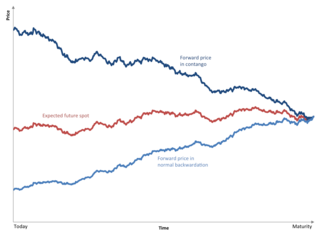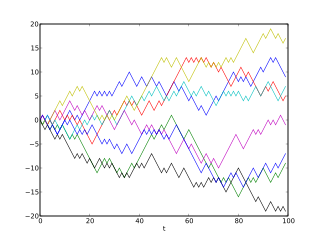Related Research Articles

Contango is a situation where the futures price of a commodity is higher than the expected spot price of the contract at maturity. In a contango situation, arbitrageurs or speculators are "willing to pay more [now] for a commodity [to be received] at some point in the future than the actual expected price of the commodity [at that future point]. This may be due to people's desire to pay a premium to have the commodity in the future rather than paying the costs of storage and carry costs of buying the commodity today." On the other side of the trade, hedgers are happy to sell futures contracts and accept the higher-than-expected returns. A contango market is also known as a normal market, or carrying-cost market.
In finance, technical analysis is an analysis methodology for analysing and forecasting the direction of prices through the study of past market data, primarily price and volume. Behavioral economics and quantitative analysis use many of the same tools of technical analysis, which, being an aspect of active management, stands in contradiction to much of modern portfolio theory. The efficacy of both technical and fundamental analysis is disputed by the efficient-market hypothesis, which states that stock market prices are essentially unpredictable, and research on whether technical analysis offers any benefit has produced mixed results.
Swing trading is a speculative trading strategy in financial markets where a tradable asset is held for one or more days in an effort to profit from price changes or 'swings'. A swing trading position is typically held longer than a day trading position, but shorter than buy and hold investment strategies that can be held for months or years. Profits can be sought by either buying an asset or short selling. Momentum signals have been shown to be used by financial analysts in their buy and sell recommendations that can be applied in swing trading.
Algorithmic trading is a method of executing orders using automated pre-programmed trading instructions accounting for variables such as time, price, and volume. This type of trading attempts to leverage the speed and computational resources of computers relative to human traders. In the twenty-first century, algorithmic trading has been gaining traction with both retail and institutional traders. It is widely used by investment banks, pension funds, mutual funds, and hedge funds that may need to spread out the execution of a larger order or perform trades too fast for human traders to react to. A study in 2019 showed that around 92% of trading in the Forex market was performed by trading algorithms rather than humans.

Computational finance is a branch of applied computer science that deals with problems of practical interest in finance. Some slightly different definitions are the study of data and algorithms currently used in finance and the mathematics of computer programs that realize financial models or systems.
Global macro is an investment strategy based on the interpretation and prediction of large-scale events related to national economies, history, and international relations. The strategy typically employs forecasts and analysis of interest rate trends, international trade and payments, political changes, government policies, inter-government relations, and other broad systemic factors.
In finance, a trading strategy is a fixed plan that is designed to achieve a profitable return by going long or short in markets. The main reasons that a properly researched trading strategy helps are its verifiability, quantifiability, consistency, and objectivity.

Commodities Corporation was a financial services company, based in Princeton, New Jersey that traded actively across various commodities. The firm was noted as one of the leading commodity and futures trading firms. CC is credited for launching the careers of many notable hedge fund investors and for its influence on global macro investing.
The following outline is provided as an overview of and topical guide to finance:
George Lane was a securities trader, author, educator, speaker and technical analyst. He was part of a group of futures traders in Chicago who developed the stochastic oscillator, which is one of the core indicators used today among technical analysts. Lane was also President of Investment Educators Inc. in Watseka, Illinois, where he taught investors and financial professionals basic and advanced technical analysis methods. He popularized the stochastic oscillator.
Linda Bradford Raschke (/'ræʃki/) is an American financier, operating mostly as a commodities and futures trader.

Richard Davoud Donchian was an American commodities and futures trader, and a pioneer in the field of managed futures.
Robert R. Prechter Jr. is an American financial author, and stock market analyst, known for his financial forecasts using the Elliott Wave Principle. Prechter is an author and co-author of 14 books, and editor of 2 books, and his book Conquer the Crash was a New York Times bestseller in 2002. He also has published monthly financial commentary in the newsletter The Elliott Wave Theorist since 1979, and is the founder of Elliott Wave International and New Classics Library. Prechter served on the board of the CMT Association for nine years, and as its president in 1990–1991. He has been a member of Mensa and Intertel. In recent years Prechter has supported the study of socionomics, a theory about human social behavior.
Quantitative analysis is the use of mathematical and statistical methods in finance and investment management. Those working in the field are quantitative analysts (quants). Quants tend to specialize in specific areas which may include derivative structuring or pricing, risk management, investment management and other related finance occupations. The occupation is similar to those in industrial mathematics in other industries. The process usually consists of searching vast databases for patterns, such as correlations among liquid assets or price-movement patterns.
Seasonal spread traders are spread traders that take advantage of seasonal patterns by holding long and short positions in futures contracts simultaneously in the same or a related commodity markets, such as the Chicago Mercantile Exchange, the New York Mercantile Exchange and the London Metal Exchange among others.
John J. Murphy is an American financial market analyst, and is considered a proponent of inter-market technical analysis, a field pioneered by Michael E.S. Gayed in his 1990 book. He has authored several books including Technical Analysis of the Futures Markets. He later revised and broadened this book into Technical Analysis of the Financial Markets.
A commodity trading advisor (CTA) is US financial regulatory term for an individual or organization who is retained by a fund or individual client to provide advice and services related to trading in futures contracts, commodity options and/or swaps. They are responsible for the trading within managed futures accounts. The definition of CTA may also apply to investment advisors for hedge funds and private funds including mutual funds and exchange-traded funds in certain cases. CTAs are generally regulated by the United States federal government through registration with the Commodity Futures Trading Commission (CFTC) and membership of the National Futures Association (NFA).

Interactive Brokers LLC (IB) is an American multinational brokerage firm. It operates the largest electronic trading platform in the U.S. by number of daily average revenue trades. The company brokers stocks, options, futures, EFPs, futures options, forex, bonds, funds, and some cryptocurrencies.

In finance, MIDAS is an approach to technical analysis initiated in 1995 by the physicist and technical analyst Paul Levine, PhD, and subsequently developed by Andrew Coles, PhD, and David Hawkins in a series of articles and the book MIDAS Technical Analysis: A VWAP Approach to Trading and Investing in Today's Markets. Latterly, several important contributions to the project, including new MIDAS curves and indicators, have been made by Bob English, many of them published in the book.
Jason Goepfert is an American researcher and columnist focused on the development of behavioral finance. Prior to founding Sundial Capital Research, he was the manager of back office operations for Deephaven Capital Management, a Minnesota-based hedge fund, and Wells Fargo's online brokerage unit.
References
- ↑ "Quote from The Technical Analyst (2009)" (PDF). Archived from the original (PDF) on 2015-11-24. Retrieved 2015-11-23.
- ↑ Quote from Information Management Network (www.imn.org) Archived 2011-10-11 at the Wayback Machine
- ↑ Extract from Alpha Trading (Wiley, 2011)
- ↑ Quote from www.moneymentor.com
- ↑ From ET Business College
- ↑ Ariad GmbH website
- ↑ Aquantum Group website
- ↑ Trading Lessons Learned the Hard Way (Futures, 2002)
- ↑ Crossover Relative Value Trading (Futures, December 2008)
- ↑ Interview with Perry Kaufman (The Technical Analyst, May 2009) Archived 2013-03-12 at the Wayback Machine
- ↑ "Interview of Perry Kaufman, author of the bible of the trading systems (AutomatedTrading.eu, January 2013)". Archived from the original on 2013-04-23. Retrieved 2013-01-05.
- ↑ A Book Review & Interview with Perry Kaufman [ permanent dead link ]
- ↑ "Algorithmic trading, evolution to the Future". Archived from the original on 2016-08-16. Retrieved 2016-07-01.
- ↑ Portfolio Allocation Using Genetic Algorithms [ permanent dead link ] (IFTA. Madrid, 2004)
- ↑ Model Performance and Risk Metrics (Technical Analyst Conference, London, 2009) Archived 2012-04-25 at the Wayback Machine
- ↑ The Impact of Global Investing on Asian Markets (Synopsis) (Asian Financial Forum, Hong Kong, January 2011)
- ↑ The Impact of Global Investing on Asian Markets (Presentation) (Asian Financial Forum, Hong Kong, January 2011)
- ↑ Website of Aquantum Group
- ↑ Website of Ariad GmbH